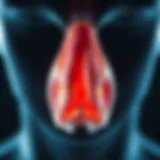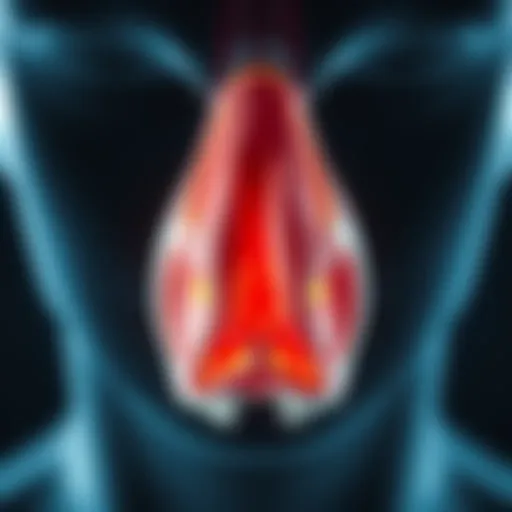Understanding the Shelf Life of Benefiber Supplements


Intro
Dietary fiber is an unsung hero in the realm of nutrition, often overshadowed by flashy diets and supplements that promise quick fixes. However, when it comes to supporting digestive health, fiber plays an indispensable role. Among the myriad of fiber supplements available on the market, Benefiber stands out as a popular choice for individuals seeking relief from digestive discomfort while striving for overall well-being. As with any health product, a meaningful question arises: does this staple fiber supplement have an expiration date?
In this article, we’ll dive headfirst into the nitty-gritty of Benefiber’s lifespan, its efficacy over time, and the particulars of proper storage. Understanding how to maintain the supplementary quality of Benefiber is crucial for consumers who want to reap its health benefits fully.
Key Benefits
When discussing Benefiber, it’s essential to highlight its myriad benefits—particularly in the realms of physical health and mental well-being.
Physical Health Benefits
- Supports Digestive Health: Benefiber primarily consists of wheat dextrin, a soluble fiber that encourages regular bowel movements. This not only alleviates constipation but also aids in maintaining a healthy gut microbiome.
- Maintains Cholesterol Levels: Studies indicate that increasing soluble fiber intake can contribute to lowering overall cholesterol levels. Benefiber can play a role in this, potentially helping to minimize the risk factors associated with heart disease.
- Promotes Satiety: For those who are strugglin with weight management, incorporating fiber into meals contributes to a feeling of fullness, helping control cravings and reduce snacking.
- Regulates Blood Sugar Levels: Benefiber may also aid in modulating blood sugar levels, particularly beneficial for individuals with diabetes.
Mental Well-being Enhancements
- Gut-Brain Connection: The link between digestive health and mental wellness has garnered attention in recent research. An optimally functioning gut can positively affect mood and cognitive function, suggesting that Benefiber may indirectly support mental health as well.
- Decreased Anxiety: While fiber is not a direct treatment for anxiety, the regulation of blood sugar levels and improved digestive health can contribute to overall well-being, making daily stressors easier to manage.
"A healthy gut leads to a healthy mind; when digestive systems function well, the brain thrives."
Practical Tips
Once we’ve established the benefits, it’s time to focus on how to maximize your experience with Benefiber. Here are some practical tips:
Effective Supplementation
- Daily Consistency: Integrate Benefiber into your daily routine for continuous benefits. Whether mixed into your morning smoothie or sprinkled on your cereal, maintaining a consistent intake is crucial.
- Hydration Matters: Increase your water intake alongside fiber consumption to assist your digestive system in processing the fiber efficiently.
Storage Guidelines
- Cool and Dry Conditions: Keep Benefiber stored in a cool, dry place away from direct sunlight. Heat and moisture can lead to degradation of the product over time.
- Check for Changes: Before using, inspect the texture and smell. Any unusual changes may indicate that the product has deteriorated, regardless of the expiration date.
Taking these steps ensures that you not only enjoy the goodness of Benefiber but also keep its effects working in your favor for longer.
Overview of Benefiber
Understanding Benefiber is integral to grasping the evolution of dietary fiber supplements in today's health landscape. Benefiber offers a simple yet effective way to incorporate fiber into the daily diet. As consumers increasingly prioritize digestive health, this product serves as a convenient option for enhancing fiber intake. It’s worth noting that fiber is not just an accessory in our diets; it plays a pivotal role in promoting digestive function and overall wellness.
Benefiber's popularity has surged, mainly due to its unique qualities and ease of use. The product is largely comprised of wheat dextrin, a soluble fiber that adds bulk to stool without the discomfort that some insoluble fibers might cause. This characteristic allows it to be integrated into various foods and beverages, thereby encouraging more individuals to achieve their necessary fiber intake without disrupting their routine.
While discussing Benefiber, it’s vital to address key elements like its definition, purpose, and ingredients. Doing so empowers consumers, health professionals, and fitness instructors alike to make educated decisions regarding their health and dietary need. Moreover, understanding how to store this supplement correctly and discern its quality over time ensures that individuals can maximize the benefits that Benefiber offers.
To summarize, the overview of Benefiber not only sheds light on its essential functions but also traces its relevance in today's health conversations. Knowledge about the product’s composition and purpose significantly enhances consumer confidence, allowing individuals to leverage the benefits of fiber in a modern dietary context.
Definition and Purpose
Benefiber is defined as a dietary fiber supplement designed to support digestive health. It primarily includes wheat dextrin, which is a non-viscous soluble fiber. The purpose of Benefiber is multifaceted: it helps maintain bowel regularity, supports a healthy digestive system, and contributes to maintaining balanced dietary fiber intake. This easy-to-use product can be conveniently mixed into beverages and foods without changing their taste or texture, making it an appealing choice for those looking to improve their overall fiber consumption.


Ingredients Breakdown
The primary ingredient in Benefiber is wheat dextrin, a soluble fiber derived from wheat starch. This component is what allows Benefiber to dissolve completely in water or other liquids without leaving a gritty texture. Aside from wheat dextrin, the product is typically gluten-free, aligning with dietary preferences of many individuals today. The absence of artificial flavors, colors, or sweeteners further enhances its appeal, as more consumers search for clean, straightforward dietary options. Moreover, it's crucial to recognize how these ingredients work synergistically to promote digestion and improve overall gut health, emphasizing the role of fiber in everyday nutrition.
Understanding Expiration Dates
Understanding December dates is essential for anyone looking to maintain their health through supplements. This section focuses on what these dates actually mean and the general shelf life of dietary supplements like Benefiber. Knowing how expiration dates work allows you to be well-informed about the products you’re using. It can guide you toward making better health choices
What Expiration Dates Actually Mean
Expiration dates are essentially a stamp of quality that tells you how long a product should maintain its stated potency and safety. These dates aren’t arbitrary. Instead, they arise from thorough testing conducted by manufacturers to understand how long their products remain effective and safe for consumption.
When you see a date marked on your Benefiber, it usually signifies the end of a period in which the product’s quality is guaranteed. However, this does not mean the supplement suddenly becomes harmful post-expiration.
For these products:
- They degrade gradually. After the expiration date, the ingredients may start to lose effectiveness over time, but this doesn’t mean they are necessarily bad or toxic.
- Different ingredients expire at different rates. In the case of Benefiber, which mainly contains wheat dextrin, the changes might not be immediate, but the fiber's ability to aid digestion and maintain regularity may diminish.
- Environmental factors play a role. Storage conditions can greatly affect how long a supplement lasts. For instance, exposure to heat or moisture can accelerate degradation.
Shelf Life of Dietary Supplements
When it comes to dietary supplements like Benefiber, their shelf life varies based on multiple factors. Typically, the shelf life can range from one to two years, depending on the formulation and storage conditions. It’s crucial to pay attention to these details to ensure you get the best benefits from your fiber supplement.
Consider the following elements that affect the shelf life:
- Formulation: Powdered forms, like Benefiber, generally have a longer shelf life than liquid forms because they are less prone to microbial growth and spoilage.
- Packaging: Products sealed in airtight containers tend to last longer as they are less likely to be impacted by air exposure.
- Additives: Some brands may include preservatives that could extend the shelf life. This is significant to evaluate when choosing a product.
- Storage Practices: Keeping the supplement in a cool, dry place away from direct sunlight can further enhance longevity.
"The way you store a product literally can be the difference between its value and longevity."
For most effective use, consider adhering to the manufacturer’s recommendations for storage, and always take a close look at expiration dates whenever you’re purchasing or using dietary supplements. This knowledge isn’t just for gut health—it’s for overall wellbeing.
Understanding the expiration of any supplement, including Benefiber, holds significant importance in ensuring optimal health benefits. Benefiber is a widely used dietary fiber supplement aimed at improving digestive health. Knowing whether or not Benefiber expires can affect how consumers approach their use of the product, the benefits they receive from it, and ultimately their overall health.
Several factors come into play when discussing the longevity of Benefiber. Primarily, its stability and effectiveness over time relate directly to storage conditions, packaging, and the product’s inherent ingredients. When people purchase supplements, they often overlook the finer points of expiration and are left wondering about the efficacy of the product after the printed date. It's essential for users to comprehend these elements, as expired products may not only lose their punch but could also present some risks.
Research on Benefiber Stability
Research indicates that Benefiber generally has a shelf life, typically ranging from two to three years from the date of production. However, the key to unlocking its benefits lies in understanding the factors affecting its stability.
When it comes to fiber supplements, scientists have studied how moisture and humidity interact with the ingredients. Benefiber, made primarily from wheat dextrin, can be sensitive to environmental changes. A few crucial points to take note of include:
- Moisture Sensitivity: If Benefiber is stored in humid conditions, it can clump together, impacting its texture and usability. This clumping can decrease the ability of the fibers to dissolve adequately in liquids, reducing its effectiveness.
- Temperature Variations: Consistently high temperatures can lead to a degradation of the beneficial ingredients in Benefiber. Ideally, it should be kept in a cool, dry place.
- Additional Ingredients: Benefiber also may contain added flavorings and sweeteners, which could also influence its stability.
Regular monitoring of the product's condition can be beneficial. If any changes in appearance occur, such as color or texture, it might be wise to reconsider consumption. Always refer to the label for specific information on expiration.
Signs That Benefiber Has Expired
Just like you wouldn’t consume expired milk, knowing when Benefiber has passed its prime is crucial for ensuring your health. There are several telltale indicators that your Benefiber may be past its expiration date:


- Unpleasant Odor: If you open the container and detect an off-smell, it's a strong sign that the product is not fit for consumption anymore.
- Changes in Taste: When you consume Benefiber, it should have a mild taste. If you notice an unusually strong or bitter flavor, that's usually the first sign that things have gone sideways.
- Clumping or Discoloration: The powder should remain consistent. Any significant alterations in its texture or color may suggest that it has deteriorated.
- Container Integrity: If the packaging is compromised—whether through holes, tears, or improper sealing—the likelihood of contamination increases.
- Mold or Particles: Any sign of mold or unexpected particles in the powder is a significant red flag, and it’s best to discard such products immediately.
It’s important to remember that consuming expired supplements could potentially lead to digestive issues or a lack of effectiveness, further underlining the significance of heeding expiration dates.
By staying vigilant and paying attention to how Benefiber looks, smells, and tastes over time, users can take proactive steps to ensure they maximize the benefits of this vital supplement.
Factors Affecting Shelf Life
Understanding the factors that affect the shelf life of Benefiber is crucial for anyone looking to maximize the efficacy and safety of their dietary fiber supplement. Knowledge in this area not only helps maintain its quality but also ensures that consumers get the most benefits from the product.
When it comes to the longevity of Benefiber, two major elements come into play: storage conditions and packaging influence. Both of these not only determine how long the product will remain effective but can also affect its overall safety. As is often said, the devil is in the details, and paying precise attention to these aspects can keep Benefiber well within its optimal usage period.
Storage Conditions
The environment in which Benefiber is stored significantly impacts its shelf life. High humidity and temperature fluctuations can lead to deterioration. Ideally, it should be kept in a cool, dry place—think the pantry or a cabinet away from heat sources like stoves and ovens.
Here are several points to keep in mind regarding storage conditions:
- Temperature: Benefiber should ideally be stored at room temperature. Excessive heat can cause clumping or changes in texture, while extreme cold can lead to moisture problems.
- Humidity: Moisture can foster the growth of bacteria. Keeping Benefiber in a sealed container helps to shield it from humidity in the air, enhancing its longevity.
- Exposure to Light: Light can contribute to degradation. A dark cabinet or pantry is often the best location.
Failing to respect these conditions might result in products just taking a nosedive in quality, even if the expiration date has not yet arrived.
Packaging Influence
The type of packaging used for Benefiber plays a crucial role in not only storage but also in maintaining its potency. Packaging that is airtight and resistant to environmental factors helps keep the product fresh for longer. For instance, Benefiber is often found in resealable bags or opaque containers, both of which serve important functions.
Consider the following about packaging:
- Airtight Seal: An effective seal prevents moisture and airflow. This helps prolong the fiber’s longevity.
- Material: Plastic or Mylar bags are more resistant to moisture compared to cardboard boxes. Choosing plastic or other sealed materials is often more beneficial.
- Labeling: Pay attention to the packaging for storage instructions and expiration dates. Sometimes, the package itself contains valuable information about how to best keep your fiber supplement.
End
In summary, the shelf life of Benefiber is greatly influenced by its storage conditions and packaging. Keeping the supplement in an optimal environment—away from heat, light, and moisture—along with understanding how packaging works can help ensure the product remains safe for consumption and effective in delivering its benefits. With proper care, one can avoid the pitfalls that lead to premature deterioration.
Implications of Consuming Expired Benefiber
Understanding the ramifications of consuming expired Benefiber isn’t just a health trivia; it’s a significant aspect of maintaining digestive wellness. Benefiber serves as a valuable dietary supplement primarily aimed at enhancing fiber intake, which is essential for various bodily functions. As time passes, the efficacy of this supplement may dwindle, or worse, it may even pose risks to one’s health. This discussion highlights two critical implications: potential health risks and the likelihood of diminished benefits from expired products.
Health Risks Associated with Expired Products
When Benefiber surpasses its expiration date, the user opens the door to various health concerns. First and foremost, expired fiber supplements may harbor mold or bacteria, especially if they have not been stored correctly. For example, if a box sits in a damp area or has been exposed to high humidity, it increases the risk of contamination. Here are a few health risks to consider:
- Gastrointestinal Distress: Consuming expired Benefiber could lead to symptoms like bloating, cramping, or diarrhea due to possible spoilage.
- Immune Response: Expired products may trigger an immune reaction, causing discomfort or even illness, particularly in sensitive individuals.
- Allergic Reactions: As components break down over time, the chance for allergic reactions increases in some users, leading to rashes or respiratory issues.
"Using expired fiber supplements might be a gamble that isn't worth taking. Your gut deserves better!"
Potential Loss of Effectiveness


Imagine relying on Benefiber to aid your digestive system, only to find that your efforts are in vain due to it being expired. Over time, the active ingredients can degrade, leading to a significant loss of effectiveness. This may mean that your body does not receive the intended benefits, such as improved bowel regularity or overall gut health.
Consider these points when evaluating the potency of expired Benefiber:
- Fiber Breakdown: The soluble fiber in Benefiber might lose its structural integrity, making it less effective in promoting a healthy digestive process.
- Nutritional Loss: Essential nutrients that contribute to overall health may diminish over time, resulting in a product that is far from its prime.
- Incomplete Digestive Aid: If the primary purpose of taking Benefiber is to maintain a healthy gut environment, an expired product may not fulfill its promise, leaving individuals feeling disappointed.
Being aware of these implications helps consumers grasp the significance of expiration dates. Taking proactive measures regarding storage and regularly checking the expiration will aid in maximizing one's health benefits from Benefiber.
Best Practices for Storage
Proper storage of Benefiber, or any dietary fiber supplement for that matter, is paramount not only to maintain its potency but also to ensure safety. Many consumers may underestimate the impact of their storage environment on the supplement's effectiveness. When thinking about storage, one should adopt a proactive mindset—it's the first line of defense in preserving your Benefiber.
Considering this, here are some essential elements to focus on:
- Temperature Sensitivity: Dietary fiber is often sensitive to temperature fluctuations. Storing Benefiber in a cool, dry place is essential. Ideally, the storage area should maintain a consistent temperature, away from heat sources like ovens or direct sunlight.
- Humidity Control: High humidity can lead to clumping and degradation of the product. Therefore, avoiding damp areas such as basements or kitchens is wise. Utilizing airtight containers can further mitigate moisture exposure.
- Light Exposure: Benefiber should be kept away from direct sunlight. Prolonged exposure to light can compromise the integrity of the fiber and reduce its health benefits.
Adopting these practices can maximize your dietary fiber's efficiency while ensuring you get every bit of health advantage that Benefiber has to offer.
Optimal Storage Environment
The storage environment plays a significant role in determining how long Benefiber retains its quality. An ideal space should tick several boxes:
- Cool and Dry Location: Store Benefiber in a pantry or cupboard that remains well-ventilated and at a stable temperature—free from drastic shifts that can cause moisture accumulation or heat stress.
- Avoid High Traffic Areas: Keeping the supplement far from areas where it can be frequently exposed to air and humidity is beneficial. For instance, a shelf close to the cooking area is often the worst place for supplements.
- Use of Airtight Containers: If you are transferring Benefiber from its original packaging, consider using a container with a good seal. This adds a layer of protection against the external environment, helping to maintain shape and quality.
Interestingly, some people are tempted to place their fiber supplements in the refrigerator or freezer. This is often unnecessary for Benefiber. In fact, those cold environments can sometimes introduce moisture, negating the benefits of storage.
Tips for Maintaining Quality
Once you have established the right environment, certain habits can go a long way in ensuring the quality of Benefiber is not compromised:
- Check Expiration Dates Regularly: Make it a routine to check the expiration date. This simple action helps ensure you're not consuming a potentially ineffective product.
- Seal it Right: After each use, ensure the lid is replaced tightly to limit air exposure. This simple act can add weeks or even months to your supplement’s viability.
- Keep Track of Usage: Note when you open a new container. This will help in managing your expectations around its shelf life and effectiveness and remind you to be attentive to any changes in texture or odor.
- Avoid Cross-Contamination: Always use dry utensils to scoop the powder. Never dip a wet spoon into the Benefiber; moisture can ruin it faster than you think.
In summary, maintaining the quality of Benefiber demands awareness and diligence. Implement these best practices, and you’ll be well on your way to making the most out of your dietary fiber supplement. > “Quality management is no accident; it is the result of intelligent effort.”
By staying informed and vigilant in how you store Benefiber, you ensure its effectiveness in promoting health and digestive well-being.
Epilogue
When we explore the topic of Benefiber's expiration, it is vital to underpin the significant aspects that dictate its stability and efficacy. The ability of Benefiber to remain effective hinges on several factors like storage conditions, packaging, and the fundamental qualities of the ingredients themselves. Understanding these elements not only empowers consumers to make informed decisions, but it also serves to ensure that they derive the maximum health benefits that this fiber supplement has to offer.
Key Takeaways on Benefiber Expiration
- Expiration Date Variability: The expiration date on the Benefiber package reflects the period during which the product is expected to maintain its optimum effectiveness. However, intermittent use and external storage conditions can influence how long it really lasts.
- Signs of Expiration: Identifying changes in color, smell, or texture can be crucial. If the powder has clumps or unusual scents, it’s a signal that it should not be consumed.
- Storage Matters: Keeping Benefiber in a cool, dry place helps extend its life. Avoiding direct sunlight and moisture can protect its quality over the months.
- Health Considerations: While consuming expired Benefiber may not always pose an immediate risk, it certainly diminishes the intended health benefits, potentially leaving individuals without the necessary fiber intake that their digestive systems crave.
Final Thoughts on Dietary Fiber and Health
Dietary fiber plays a cornerstone role in maintaining digestive health. Benefiber, specifically, contributes immensely by complementing a typical diet rich in whole foods.
- Incorporating this fiber supplement can aid in digestion, regulate bowel movements, and even support heart health.
- Recognizing the value of fiber in diet is essential, but being discerning about the expiration of supplements is equally important.
- As health professionals and wellness advisors, you're armed with the knowledge that enables you to advocate for prudent use of these supplements.
"Being proactive about supplement quality can transform one's health journey. Aid your clients by encouraging mindful practices around their dietary choices."
In sum, when it comes to Benefiber, being informed about its expiration not only keeps you on track to better health but also elevates your understanding of dietary fiber's pivotal role in nurturing wellness.















